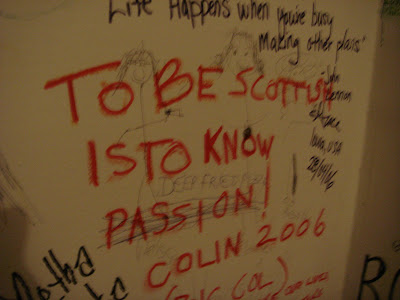If you're unfortunate enough to be living in Toronto right now, you'd also have to be living under a rock not to know that a major gathering of political leaders is taking place this coming weekend. Yes, the
G20 is coming to town, and as a consequence a lot of other regular city dwellers are being advised to either get out (
if possible) or
hunker down. Those of us with Internet connections are also
receiving regular updates on how the summit will (negatively) affect our daily lives.
 Above: portable barriers were stacked on many street corners in the downtown area.
Above: portable barriers were stacked on many street corners in the downtown area.Thankfully, the Internet snarks have been out in force, eagerly documenting the various varieties of "FAIL" that have been committed directly and indirectly by the federal government (let's face it: they did the planning. it's
a fair cop--pardon the pun).
 Above: on Front Street, what appears to be a surveillance device--or possibly a Claes Oldenburg interpretation of the CN Tower.
Above: on Front Street, what appears to be a surveillance device--or possibly a Claes Oldenburg interpretation of the CN Tower.These include--to list only the most obvious--
the now-infamous "
Fake Lake",
the fence, the
hyperbolic trajectory of security costs, the obvious lack of discussion on certain
key areas of
policy, and the ridiculous decision to locate the summit in the heart of Toronto's downtown--one that will undoubtedly generate more
unexpected costs for the city (though it will have no impact on current Conservative support in Toronto, as
this helpful map, by Nick Boragina, shows).
 Above: at Front Street and Blue Jays Way, the sculpted baseball fans on the Rogers Centre appear to be mocking Stephen Harper's security arrangements.
Above: at Front Street and Blue Jays Way, the sculpted baseball fans on the Rogers Centre appear to be mocking Stephen Harper's security arrangements.Meanwhile, some people are still arguing that the G20 will bring in tourist revenue.
Not likely, but perhaps businesses can recoup some of their costs via the seething horde of journalists that will descend upon the area over the next few days. There are also plenty of cop-and-doughnut-shop jokes to be made here.
The photos in this post were taken yesterday as I biked around the
downtown perimeters, checking out the fence and taking a look at the rumoured masses of police just hanging out in random downtown areas. It's not every day the city goes into lockdown (thankfully), and I had to satisfy my curiosity and try to grab a few souvenir pictures.
Below: corner of Windsor & Wellington Streets.
It's clear why some folks have coined the name "
Torontonamo Bay", while even the mainstream media are describing the arrangements as
"Fortress Toronto". And yet I've heard numerous anecdotal reports of areas where security arrangements were obviously bound to fail.
 Above: "free media"...Below: A stereotypical target is shielded by the fence.
Above: "free media"...Below: A stereotypical target is shielded by the fence.
Of course, another thing that we're expected to expect during these kinds of events is
activism--or as it's usually described, "protest".
While biking back uptown from the security fence, I encountered this march (below) moving slowly along College Street. In these pictures, protesters outside the University of Toronto decry environmental abuse by corporations and G20 governments. The U of T
has been shut down for the duration of the summit, after being designated as a corral for protests (the original site had been Trinity Bellwoods Park, much further West on Queen Street).

There's been a predictable amount of
media coverage whipping up--as per usual--a discursive frenzy over the
expected Violence of Protesters; in many news articles the implicit connections are made between security procedures and 'precautions', activist events, and arrests that have been made for unrelated, illegal activity.
Of course, "if it bleeds, it leads", and nowhere is that clearer than in mainstream reporting of anti-Capitalist/anti-globalisation activism. This is important because it is a part of the complex of factors involved in representation of political agendas, and affects the potential interpretations of wider audiences (and, I would argue, their receptivity to new or different political ideas).

Along with an overwhelming (and visible) police presence; physical barriers such as fences, roadblocks and check-points; and the presence of weapons such as water cannons, tear gas and rubber bullets, fear-mongering media coverage helps to construct a situation in which legal and legitimate dissent is seen as a 'threat' (to property, especially, and more abstractly--to a way of life or to 'order, to one's political values, to the regular functioning of the city, and so on). Violence is so expected that it's framed as (or implied to be) somehow 'different' when
a protest is '
peaceful'.

Interested in photographing the G20 summit this weekend?
Here are some
tips for photographers regarding the legal technicalities; it's important to know your rights if you're planning to go into and area that is heavily policed, and where photographers are already known to have been harassed by security forces (I was lucky--I only felt myself on the receiving end of suspicious glances). You should also
know your rights if you participate in any kind of protest/demonstration or action.
If you're looking for more information about activist events, and/or for some alternative/independent coverage of the events, check out the G8/G20 Toronto
Community Mobilization page, and the
Toronto Media Co-op; there's also an interesting
guide to the G20 for activists. You can check out--and post to--the Twittersphere, where the hashtags
#G20 and
#G20report are the best with which to label your summit-related tweets, though with the latter tag you'll want to stick to serious comments relating to police action, security, and information relating to activist events (take a look at other tweets to get a sense of what's appropriate); and you can also send your feedback to well-known local blog,
Torontoist.



























